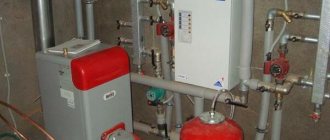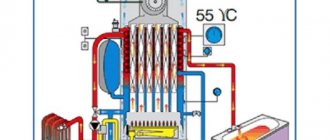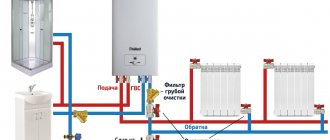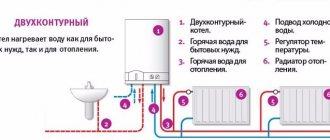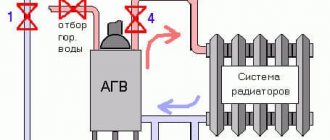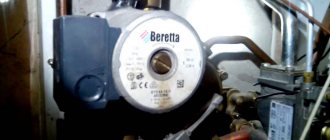Differences between double-circuit and single-circuit boilers
The main difference between a double-circuit boiler and a single-circuit boiler is the ability to heat not only the coolant of the heating system, but also the hot water of the hot water supply system (DHW). A single-circuit gas heating boiler consists of a combustion chamber with a burner, a heat exchanger, and control automation. When you turn on the device, the fuel supply valve opens, the burner is ignited, and the process of fuel combustion in the combustion chamber begins. The burning gas fuel transfers thermal energy to a heat exchanger through which the coolant fluid passes. The coolant takes heat from the heat exchanger, in turn releasing thermal energy to the heating radiators. Special automation controls the operation of gas boiler equipment, regulates the gas supply, and maintains the specified temperature. In the presence of a standard single-circuit boiler, the water of the domestic hot water system is heated by an indirectly heated storage boiler. The boiler is equipped with a heat exchanger, heated by supplying coolant from the heating boiler. Using a simple heat extraction circuit, the required amount of cold water is heated for domestic consumption. It is clear that the use of an additional boiler complicates the system, puts additional load on the gas boiler, and requires adjustment of the operating mode of the gas boiler equipment.
Double-circuit gas boilers are available in the following versions:
- With one heat exchanger. The coolant supply mode is controlled by a special valve. If household hot water taps are closed, the coolant is supplied to the heating system. When the DHW water tap is opened, the valve shuts off the supply of coolant to the heating system and directs the coolant to the heat exchanger to heat the water of the DHW system. Of course, this solution is not very convenient, since the water takes too long to heat up.
- With two heat exchangers. This option is in great demand. Two independent heat exchangers simultaneously heat water for the heating system and hot water supply.
The website of the StroyObjectSnab Trading House presents the best examples of single-circuit and double-circuit gas boilers from well-known foreign manufacturers. Our managers will help you choose the best options according to your requirements.
Which boiler is better to choose
Let's try to compare a single-circuit boiler with a double-circuit boiler and find out which one is better to choose for your home.
A double-circuit boiler with one heat exchanger, especially a bithermic one, is an excellent solution when it is important to rationally use every centimeter of space. Where this issue is not so acute, it is better to give preference to a double-circuit boiler with separate heat exchangers
To organize hot water supply, an indirect heating boiler must be connected to a single-circuit boiler, and this will require additional space, and the cost of a single-circuit boiler together with the boiler is higher than the cost of a double-circuit boiler with similar parameters. But, like any storage water heater, an indirect heating boiler connected to a single-circuit boiler also has advantages over an instantaneous water heater that is part of a double-circuit one.
The temperature of hot water from a boiler does not depend on its flow rate, while the temperature of water from a flow-through heater may change due to this, especially when several consumers are turned on simultaneously. Just keep in mind that when the hot water in the boiler runs out, it will take time for it to heat up again. Therefore, it is necessary to calculate in advance what volume of the boiler will be optimal for uninterrupted hot water supply in specific conditions.
Double-circuit boiler - for a small country house
So, the main advantage of double-circuit boilers is space saving, the main disadvantage is the instability of hot water temperature when several consumers are turned on simultaneously. Therefore, a double-circuit boiler will be the optimal solution for a small country house.
Single-circuit boiler with boiler - for a large cottage
A single-circuit boiler together with a boiler connected to it will take up more space, but this design can stably provide hot water to several water points. Therefore, in a large cottage or permanent house, where friends or relatives may come and where hot water may be simultaneously needed in the kitchen and shower, and saving one or two square meters of space is not significant, it is better to use a single-circuit boiler in conjunction with an indirect heating boiler.
A gas boiler is an autonomous heating device, which is one of the most popular and convenient solutions for organizing heating and hot water supply in a private home. There are two types of boilers - single-circuit and double-circuit. The first ones in the basic version are intended exclusively for heating. While double-circuit ones also solve the problem of heating water. Let's take a closer look at the operating principles and differences between wall-mounted boilers.
Dimensions and power of heating boilers
The dimensions of a gas boiler are directly related to the type of design. Single-circuit gas boilers are usually available in a floor-standing version and have more substantial dimensions. They are quite bulky, occupy a large area, and weigh up to 110 kg. To heat cold water, a storage boiler is installed nearby. The main advantage of a single-circuit floor-standing boiler is its large thermal power, reaching 300 kW. Single-circuit boilers are highly reliable and have a minimum of electronics. Along with this, the installation of this equipment is more complicated, since the expansion tank, circulation pump, and connecting fittings are mounted separately.
Double-circuit wall-mounted boilers are smaller in size. They have better efficiency and lighter weight. Most importantly, all additional equipment is already installed inside the body of the double-circuit boiler. All that remains is to connect the main gas pipe, heating and hot water system pipelines to the double-circuit boiler. Double-circuit wall-mounted boilers have a low power of about 40 kW. Carrying out installation work is not particularly difficult.
Let’s answer the popular question about how much power a gas boiler is needed for a private home. The required power of a single-circuit or double-circuit gas boiler for a home is calculated based on a number of parameters. The dimensions of the building’s premises, number of floors, number of windows, average temperatures, and expected hot water consumption are taken into account. The employees of the StroyObjectSnab Trading House will help you correctly perform the necessary calculations in the shortest possible time.
Boiler elements
Design features of a double-circuit boiler
Before using the unit, you need to consider its structure. The boiler consists of the following elements:
- Burner. It is located in an open or closed combustion chamber. This part provides heating of the coolant and is a heat generator for hot water supply.
- The combustion chamber.
- Circulation pump. Thanks to it, the coolant moves in the system.
- Three-way valve. Provides switching between water heating and heating modes.
- Main heat exchanger. Location: under the burner. The liquid is heated in it.
- Secondary heat exchanger. Necessary for preparing hot water.
- Automation. Thanks to it, the operating parameters of the heating equipment are regulated. If a malfunction occurs in the unit, the automation simply turns it off.
At the bottom of the device there are pipes for connecting heating and water supply system pipes, as well as a device for removing combustion products.
What to look for when buying a boiler
Of course, any buyer is guided by his own requirements when purchasing gas boiler equipment. Someone has the necessary space for a boiler room and wants to get a gas boiler with maximum power. In such a situation, the best choice would be to purchase a single-circuit floor-standing boiler together with a storage boiler. This solution will allow you to heat a large building and constantly have a decent supply of hot water. Owners of small houses should take a closer look at different models of wall-mounted double-circuit boilers. It is worth noting that dual-circuit models with built-in hot water storage are available for sale. This double-circuit boiler has larger dimensions. A significant advantage is the availability of a constant volume of hot water. You won't have to wait for running water to heat up after turning on the tap. Along with this, the flow-through heating method is more economical, since the water is heated only when necessary, and not constantly. We advise you to consult with specialists from the StroyObjectSnab Trading House who can provide qualified assistance when purchasing a gas boiler.
Double-circuit heating system: design, features, connection
There are two most important conditions for comfortable housing: the presence of heating and hot water supply. To ensure these conditions, you can use separate systems, or you can install a double-circuit boiler. We will tell you the difference between single-circuit and double-circuit heating systems, what are the features and advantages of double-circuit heating.
A double-circuit boiler is easily distinguished by its four incoming pipes.
Heating with two circuits
Operating principle and design of the boiler
The photo shows an example of piping a gas boiler.
First of all, we want to define a dual-circuit system, and also consider the principle of its operation.
Important! A dual-circuit system is a system that combines the functions of heating and hot water supply by organizing two independent circuits with different water temperatures.
The yellow line is the gas main.
You must understand that the temperature of the coolant in the heating system reaches 95 degrees, while the temperature of the hot water supply according to paragraph 2.4 of SanPiN 2.1.4.2496-09 is 60 degrees. This means that the heat generator will operate in different modes.
As a rule, a double-circuit boiler has one closed heating heat exchanger and one flow-through hot water heat exchanger.
Scheme for dual-circuit heating using a gas burner.
So, let's look at the principle of operation of the device:
- The coolant enters the heat exchanger (1), where it is heated by the gas burner (2) and sent to the heating system under the action of the circulation pump (4), thus moving in a circular motion in a closed heating circuit;
- When the hot water supply is turned on, the three-way valve (6) is activated, and the coolant begins to circulate through the heat exchanger (5) inside the boiler, but it does not enter the heating system;
- Tap water enters the heat exchanger (5), where it is heated by the coolant and sent to the hot water supply system;
- The internal small circuit is also closed and equipped with an expansion tank (3), which compensates for the expansion of the coolant when heated.
Double-circuit boiler or indirect heating boiler?
The owner of a private house or cottage almost always faces a problem regarding obtaining hot water.
Previously, various systems for producing hot water were widely used for these purposes, but the most popular, from the point of view of practicality and economy, were primitive gas water heaters or, at best, bulky homemade indirect heating boilers.
What changed?
Gas water heaters have made great strides forward in their design, reliability and convenience. And, moreover, in some cases they have changed beyond recognition, turning into wall-mounted gas boilers, with an open combustion chamber using air from the room for combustion, or even with a closed one, with air intake from the outside and forced smoke removal through a coaxial chimney. Magnificent boilers operating in fully automatic mode.
What is the difference between a double-circuit gas boiler and a gas water heater? The fact that in a double-circuit boiler there are two heat exchangers, one of which heats the coolant of the heating system, and the other heats water for household needs. Or they are collected into one heat exchanger, in which the water of the heating system and domestic hot water move in opposite directions, then this single heat exchanger is called bithermal.
Such boilers are now very popular, they are simple, cheap and reliable. But in every seemingly ideal option, there is always a catch.
Double-circuit gas boilers have frankly weak performance in terms of generating hot water. Depending on the power, a double-circuit boiler is capable of heating in continuous mode from 6-7 to 10-12 liters of hot water per minute in the best case. If the house has a kitchen sink and shower, this is quite enough. And if the family is large, there are two showers and there is also a bathtub, then it’s worth thinking about; a double-circuit boiler may not cope. No, one way or another it will provide the required hot water for some time, but during this time the water in the heating system may have time to cool down. In addition, if the heat exchanger is bithermic, when the boiler switches to heating, the cooled water from the heating system will enter the heat exchanger, which is very heated by the preparation of hot water. The automation will notice an excessively large temperature difference and turn off the boiler, putting it into emergency mode until the heat exchanger cools down, and some models of gas boilers will require manual activation.
Another disadvantage of wall-mounted gas boilers that prepare water in heat exchangers is that the heat exchanger is heated directly by the burner flame. For a heating heat exchanger, this is nothing to worry about, since oxygen has already been removed from the water, the salts and minerals in the water during the initial filling have settled, and the same prepared, “empty” water circulates. And the water from the water supply system, used to prepare hot water, carries more and more salts and minerals. Scale is inevitable. Over time, the heat exchanger will require flushing, and in some regions this time may be very short. Professional washing of the heat exchanger with special chemicals is inexpensive and we successfully provide such services, but it must be done almost every year, and over time a decent amount of money spent on washing can accumulate.
What to do?
An ideal means of obtaining large volumes of hot water is an indirect heating boiler.
By removing heat from the heating circuit, fed by a separate branch from the distribution manifold, the indirect heating boiler, in a boiler-friendly mode, creates a large supply of hot water, always ready for use. High-quality thermal insulation, made of solid foam or expanded polystyrene, protects the water from cooling for a long time. Thanks to the powerful and long heat exchangers built into the boiler tank, they are extremely efficient and are capable of preparing really large volumes of water - showers, baths, and even Jacuzzis - all of which will be filled with large, free pressure without overloading the boiler. In addition, in an indirect heating boiler, the water supply is heated by the water of the heating circuit, and not by a flame, no overheating zones are created on the walls of the heat exchanger tubes, and much, much less scale is formed!
Also, very often indirect heating boilers are equipped with an additional heating element and are able to operate without a boiler at all, during routine maintenance of the boiler or when otherwise necessary. Indirect heating boiler – always hot water. If you have a large family, several bathrooms, a bathroom, then an indirect heating boiler is your choice!
www.teplomir-nsk.ru
User manual
The connection to the gas main is carried out by employees of the gas industry.
Gas boilers are used for heating and hot water supply of apartments, private residential and country houses, and public buildings. In this case, it does not matter at all whether the system is connected to the main gas pipeline, since the units can operate on liquefied fuel, which is supplied in cylinders.
The manual for the use of gas equipment is a set of requirements and rules, compliance with which makes the operation of the device safe and efficient. Initially, the device is connected to the gas main, as well as to the water supply pipes, heating system, and electrical network. The device is connected to the main line only by qualified specialists authorized to perform such work.
If there is a need to replace parts of the device, only original spare parts are selected. If a malfunction occurs, the unit is immediately disconnected from the gas supply. It is prohibited to carry out any service work to eliminate breakdowns yourself. Before the start of the heating season, the condition of chimneys and air ducts is checked. When the equipment is turned off for a long time, the gas valve is closed.
Do not use aggressive chemicals to clean the unit. Before turning on the boiler, you need to make sure that there is coolant in the heating system, that the burner, safety valve and automation are working properly. During operation of the unit, you need to ensure that there is no smell of gas in the room. The burner is periodically cleaned of dirt.
Gas boiler circuits
The first circuit of a gas boiler always means a heating circuit. The boiler has one input and one output for heated water.
In double-circuit boilers, in addition to the first heating circuit, there is another circuit for heating drinking water in flow-through mode. And accordingly, two more pipes are added - one for cold water inlet, the second for hot water outlet.
The boiler independently switches heating from heating to the drinking (second) circuit when a flow appears in the second circuit. When heating hot water, the heating circuit does not work (does not heat up).
